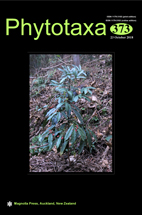Abstract
Habenaria leprieurii and H. alpestris both have histories of misleading and conflicting taxonomic identifications. We investigated the taxonomy, phylogenetic relationships, and sectional classification of those and related species. Examinations of type specimens and large numbers of additional live and herborized samples revealed that H. schwackei, H. amazonica, and H. platydactyla are conspecific with H. leprieurii and are characterized by having a white corolla and a long pedicel. The species previously treated as H. leprieurii, is H. cruegerii, of which H. culmiformis is a synonym and are characterized by the green flowers, short pedicel and the straight ovary, parallel to the inflorescence axis, curved only in the apex. A species from central-western Brazil, previously treated as H. alpestris, corresponds to a new species, described here as H. omissa, while H. alpestris is conspecific with H. melanopoda. We propose a new circumscription for H. sect. microdactylae, including H. leprieurii, H. heptadactyla, H. cruegerii, and the newly described H. omissa and H. cruegeri var. flaviflora—which now form a morphologically homogeneous section. An identification key, plus descriptions, notes, illustrations, and lists of specimens for each species are presented.

